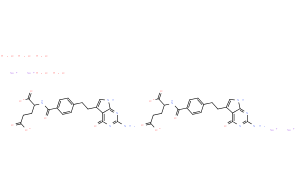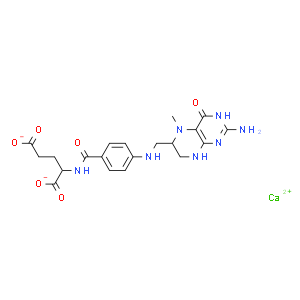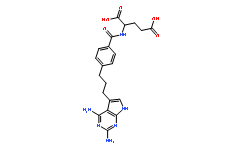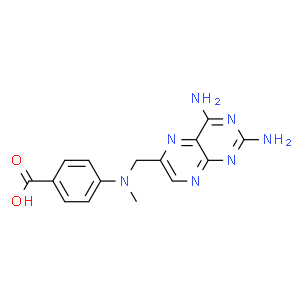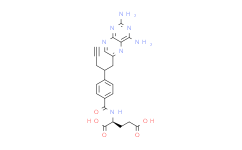| 中文名称: | 二氨藜芦啶 | ||||
|---|---|---|---|---|---|
| 英文名称: | Diaveridine | ||||
| 别名: | 5-(3,4-二甲氧苄基)-2,4-嘧啶二胺 EGIS-5645 | ||||
| CAS No: | 5355-16-8 | 分子式: | C13H16N4O2 | 分子量: | 260.29 |
| CAS No: | 5355-16-8 | ||||
| 分子式: | C13H16N4O2 | ||||
| 分子量: | 260.29 | ||||
| MDL: | MFCD00057349 | EINEC: | 226-333-3 | ||
| EINEC: | 226-333-3 | ||||
基本信息
|
产品编号:D10610 |
|||||
|
产品名称:Diaveridine |
|||||
|
CAS: |
5355-16-8 |
储存条件 |
粉末 |
2-8℃ |
四年 |
|
|
|
||||
|
分子式: |
溶于液体 |
-80℃ |
两年 |
||
|
分子量 |
260.29 |
-20℃ |
一个月 |
||
|
化学名: |
|||||
|
Solubility (25°C) |
体外 |
DMSO |
25mg/mL (96.04mM) |
||
|
Ethanol |
|
||||
|
Water |
|
||||
|
体内 |
现配现用 |
|
|||
|
<1mg/ml表示微溶或不溶。 |
|||||
|
普西唐提供的所有化合物浓度为内部测试所得,实际溶液度可能与公布值有所偏差,属于正常的批间细微差异现象。 |
|||||
|
请根据产品在不同溶剂中的溶解度选择合适的溶剂配制储备液;⼀旦配成溶液,请分装保存,避免反复冻融造成的产品失效。 |
|||||
制备储备液
|
浓度
溶液体积 质量 |
1mg |
5mg |
10mg |
|
1mM |
3.8419mL |
19.2093mL |
38.4187mL |
|
5mM |
0.7684mL |
3.8419mL |
7.6837mL |
|
10mM |
0.3842mL |
1.9209mL |
3.8419mL |
|
50mM |
0.0768mL |
0.3842mL |
0.7684mL |
生物活性
|
产品描述 |
二氢叶酸还原酶 (DHFR) 的抑制剂,对于野生型 DHFR 的 Ki 值为 11.5nM,Diaveridine 也是一种抗菌剂。 |
|
靶点/IC50 |
Ki: 11.5nM (DHFR) Bacterial |
|
体外研究 |
Diaveridine is a dihydrofolate reductase (DHFR) inhibitor with a Ki of 11.5 nM for the wild type DHFR and also an antibacterial agent. Treatments with Diaveridine for 90 min have a strong bactericidal effect on S. typhimurium TA1535, and no bacterial growth is observed at 10μg/mL or more. Without metabolic activation, treatment with Diaveridine for 48 h, but not 24 h, causes a dose-dependent, significant increase in the frequency of aberrant metaphases. At 100 μg/mL, 60% of the metaphases contain chromosome aberrations. |
|
体内研究 |
The sperm abnormality of the Diaveridine (DVD) treatment groups at all dose levels (Diaveridine, 128 to 512 mg/kg) shows no significant differences compare with the negative control group. There are no significant differences of micronucleus between the negative control group and the Diaveridine treatment groups (Diaveridine, 128 to 512mg/kg). The chromosome aberration of the Diaveridine treatment groups at all dose levels and the negative control group are significantly lower than those in the positive control group treated with cyclophosphamide (P<0.05), indicating that Diaveridine at the doses studied does not cause abnormal chromosome aberration. The results demonstrate that the Diaveridine administration does not produce significant changes in the ratio of organ-to-body weight, compare with the negative control group in the end period of the study. |
推荐实验方法(仅供参考)
|
细胞实验: |
|
|
Cell Assay |
Cells are cultured at 37°C in a humidified atmosphere of 5% CO2 in air. The growth medium is Eagle’s MEM supplemented with 10% fetal bovine serum. In the experiment without metabolic activation, the cells are treated for 24 or 48 h continuously without a medium change. In the experiment with metabolic activation, the cells are pulse treated with test compounds (including Diaveridine) at varying doses for 6 h and incubated for 18 h in fresh culture medium. Breakage type chromatid aberrations, exchange type chromatid aberrations, breakage type chromosome aberrations, and exchange type chromosome aberrations are scored. Gaps are also counted. Mitotic index is determined from scoring 2000 cells. |
|
动物实验: |
|
|
Animal Administration |
3]Fifty male ICR mice, weighing 25 to 35 g, are assigned to five groups randomly with 10 mice in each group. Mice in the experiment groups receive Diaveridine (DVD) via IG at ed 128 mg/kg (low doses), 256mg/kg (medium doses), and 512 mg/kg (high doses) body weight for 5 consecutive days, respectively. Mice in negative and positive control groups receive IG 1% CMC-Na solvent and 40 mg/kg body weight of cyclophosphamide, respectively. The testing groups are administered 0.2mL/10 g Diaveridine (mixed with 1% of CMC-Na, to obtain the concentration of 2mg/mL.) body weight, once a day, for 5 days. The behavioral changes are recorded on the daily basis. |
本计算器可帮助您计算出特定溶液中溶质的质量、溶液浓度和体积之间的关系,公式为:
质量 (g) = 浓度 (mol/L) x 体积 (L) x 分子量 (g/mol)
摩尔浓度计算公式
用本工具协助配置特定浓度的溶液,使用的计算公式为:
开始浓度 x 开始体积 = 最终浓度 x 最终体积
稀释公式
稀释公式一般简略地表示为:C1V1 = C2V2 ( 输入 输出 )



